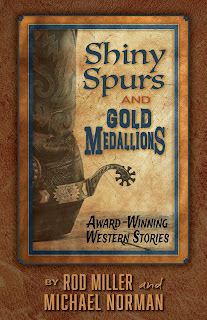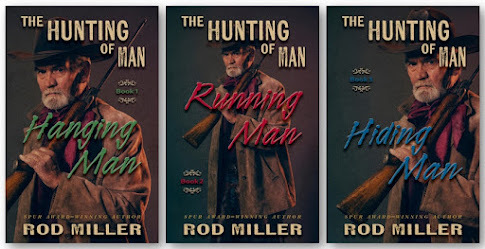Rod Miller's Blog, page 2
April 10, 2025
Trees and Indians.
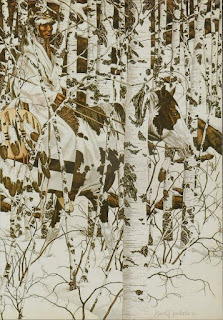
Years ago,I lived on Oak Street. Living there always brought to mind the old joke thatwhen real estate developers start a project, they cut down all the trees and thenname the streets after them.
Something similar, only infinitely more tragic, has taken place since the firstEuropeans set foot on land that was to become the United States of America: ourforefathers—government, military, business interests, and ordinary citizens—allbut exterminated the Indian tribes that already lived here, then named things afterthem. States, counties, cities, towns, rivers, lakes, mountains, canyons,valleys, and more carry names derived from Native American languages.
Of our United States, 27 of them—27!—carry names that come from the languagesof the tribes that occupied the land before being forced off by one nefariousmeans or another.
Here in my home state of Utah (named for the Ute Indians) there are fivecounties with Indian names, along with three cities and towns, at least onemountain and two mountain ranges, and a whole lot of other stuff. And Utah isnot unusual—in fact, there are many, many states whose maps are marked withmany, many more names borrowed from Indian words.
I suppose in some sense it is a sign of respect. But it is impossible tobelieve that whatever smidgen of honor is involved in any way scratches thesurface of the damage we have done—and still do—to the people who lived herewhen our ancestors arrived.
(ABOVE:The Indian riding through the trees is a work of art by Bev Dolittle)
March 27, 2025
The Anti-Western?
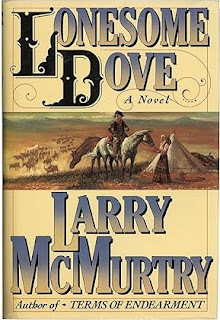
Socialmedia, I am told, is all abuzz these days with Larry McMurtry’s PulitzerPrize-winning novel, Lonesome Dove. While I lack even a passingacquaintance with the online exchanges, I have it on good authority that thebook is experiencing a resurgence, heaped with praise all the way up to andincluding being christened the greatest book of all time.
Much of the discussion revolves around Lonesome Dove being declared bysome the “anti-Western.” I’m not sure what that means. It may have to do withthe idea that McMurtry attempts to present a realistic portrayal of the OldWest, warts and all—a departure from the romanticized, glorified versionpopularized by Owen Wister, Zane Grey, Louis Lamour, and others, continuingright up to our time. (Not that those good-versus-evil tales with theirnecessary triumph of the good-guy hero are unusual in literature. The samepattern holds true at least as far back as Homer and the legends of King Arthur,and continues in cozy mysteries, thrillers, fantasies, private-eye novels, Westerns,and even much of literary fiction.) But somehow, calling Lonesome Dovethe “anti-Western” gives supercilious readers permission to read a Westernnovel—something their refined, sophisticated tastes would not allow otherwise.
But there is nothing new in Lonesome Dove’s attempt to present a raw,unvarnished version of the Old West. It has been done before and since, manytimes. Andy Adams tried it in 1903 in The Log of a Cowboy, a trail drivenovel that, unlike Lonesome Dove, grew out of the author’s personalexperiences.
Paso Por Aqui, penned by Eugene Manlove Rhodes in 1925, cannot bewritten off as glamorizing its subject. Nor can The Ox-Bow Incident byWalter Van Tilburg Clark, which has been turning the mythical Old West on itshead since 1940. Glendon Swarthout’s The Shootist (not the movie, whichpulls Swarthout’s punches) breaks all the expectations of the triumph of goodover evil. True Grit by Charles Portis also represents a departure.
A previous Pulitzer Prize-winning novel set in the Old West, Angle of Reposeby Wallace Stegner, presents a realistic view borrowed from the experiences ofreal-life Western transplant Mary Hallock Foote.
It would be difficult to depart from the romantic view further than CormacMcCarthy does in Blood Meridian and The Crossing, or E.L.Doctorow in Welcome to Hard Times. Loren D. Estleman’s Bloody Seasondemonstrates the dubious distinctions between heroes and villains. And while aglamorized view of the Old West peeks through in Ivan Doig’s Dancing at theRascal Fair and The Meadow by James Galvin, it is portrayed throughthe eyes of some characters, and is countered by the notions of othercharacters.
Are these examples—and others out there—“anti-Westerns,” or are they merelyWestern literature, sharing the stage with the broad range of plots, points ofview, and approaches that make reading good books of any genre a joy? I cast myvote for the latter. To me, Lonesome Dove is not “anti-Western” at all,but “pro” good reading and a great Western novel.
March 11, 2025
Catching up.
Not longago, I dusted off a favorite LP record album from the past and gave it alisten. It’s still good. The record, by legendary country singer and songwriterRoger Miller (no relation), is titled, “Dear Folks Sorry I Haven’t WrittenLately.” Well, folks, I haven’t written lately here either, although I doubt Ihave been missed.
The lastfew months on the writing front have been tied up with a lot of busy work.Here’s a rundown.

Andthe River Ran Red,my historical novel about the Massacre at Bear River, is now available inpaperback and eBook from publisher Speaking Volumes at all the onlinebooksellers. Find it in paperback at Amazon US and Barnes & Noble; and in eBook at Amazon US, Apple Books, Barnes & Noble, Google Play, and Kobo Books.
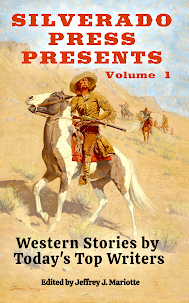
Also justreleased is an anthology of Western short stories that, so far as anyone candetermine, it is the first crowd-funded Western ever. It’s the result of a lotof hard work by editor Jeff Mariotte and Kickstarter. It’s now available onlineeverywhere in paperback and eBook. My story, “The Incident Above Mentioned” isthe lead story in Silverado Press Presents WesternStories by Today’s Top Writers .
Anothercollection of short stories is due in large print from Thorndike Publishing inlate July. This one is a collaboration with friend and fellow author Michael Norman. Shiny Spurs and Gold Medallionsfeatures our award-winning Western stories (Western Writers of America SpurAwards, Will Rogers Medallion Awards, and elsewhere), along with some newofferings.
Thenthere’s Buckoffs and Broken Barriers: Rodeo Poems, a new collection ofpoetry in the works at publisher Speaking Volumes. The book, as the titlesuggests, is all about rodeo, and includes poems both serious and silly. Somehave appeared in magazines long ago, some in other collections and anthologies,and many are published here for the first time.
SpeakingVolumes also has the manuscript for a new novel featuring RawhideRobinson, ordinary cowboy andextraordinary spinner of tall tales. This adventure, titled Rawhide RobinsonRides with Old Blue, has our raconteur in the employ of Charlie Goodnight,trailing cattle northward led by Goodnight’s legendary lead steer, Old Blue.But Old Blue keeps walking even after reaching Ogallala, and Rawhide Robinsonfollows the big steer into the great white north to fetch him back to Texas.

And, amidstall that, I have been writing short articles from Western history for theonline publication Cowboy State Daily. Of late they have published mypieces about Charlie Siringo; the 1896 Montpelier, Idaho bank robbery; theParcel Post Bank in Vernal, Utah; and Wild Bill Hickok’s gunfight in Springdale,Missouri.
Also onthe horizon is a new novel from Speaking Volumes that will see the light of daylater this year. Where the Long Trail Ends is set on a cattle drive onthe Chisholm Trail. The title is a line from a poem by George Rhoades, an old college professor of mine,who is also an award-winning poet. Then there’s a new novel about the PonyExpress, The Mail Must Get Through, as well as paperback and eBookeditions of my previous hardcover books This Thy Brother and BlackJoe and Other Selected Stories.
After allthat, who knows what else the future holds?
Sorry to fillyour day with so much chin music, but I wanted to make up for lost time.
January 11, 2025
Stupid words.
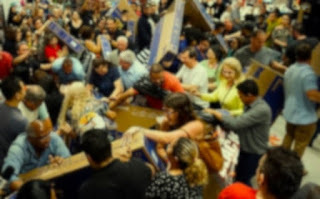
For years,decades, I earned my daily bread in the advertising trade, working inadvertising agencies. My job was on the creative side, developing strategies thatwould most effectively lure customers, then turning them into ads in whatevermedia was required. The goal was always to use ideas and words and pictures andmusic to arouse interest and keep viewers or readers or listeners watching orreading or listening long enough to absorb whatever message we wished toconvey. We always believed the audience deserved some level of respect inexchange for our intrusion into their lives.
But mostpeople in the advertising business, like most people in most businesses, do notcare all that much. They don't care if the advertising is creative or entertaining or inventiveor unexpected. They are just putting in the time, putting their emphasis onlooking and sounding good in the endless supply of meetings, both within theagency and with clients. They do not want to rock the boat; “give the clients what they want,” is the force that motivates them.
And thatis why most advertising falls somewhere between invisible and inane.
That iswhy some guy in a tie somewhere decided that holding a “sale” is no longer goodenough. That the public is no longer interested in discounted prices. Thatcalling a sale a “sales event” would excite the audience (for whom they havelittle respect) into showing up in frenzied droves and parting with theirmoney. After all, isn’t the very idea of an “event” exciting? Wouldn’t itdeserve three—no, four—exclamation points in social media?
While thisearth-shattering development has little effect on audiences, it somehow resonateswith advertisers. So it’s, so long to a “sale,” and hello to a “sales event.”Car companies, in particular, have made adding “event” to a “sale” mandatory,it seems. And “sales event” has disseminated, propagated, and circulated untilit is ubiquitous.
Mostpeople probably don’t even notice it, just as they don’t notice most of thedumbed-down, simple-minded advertising messages that interrupt every aspect oftheir lives. But no one, I daresay, is so excited, so electrified, sohypnotized by a “sales event” as opposed to a mere “sale” that they rush rightout and gleefully part with their money.
I could bewrong. I haven’t been in a client meeting in years. But one thing’s for sure—somebodyis stupid when it comes to “sales events.” It could be me.
December 15, 2024
Utah cowboys at the National Finals Rodeo
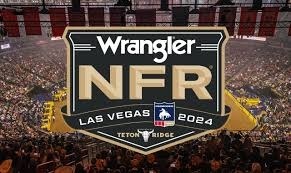
Ten of thebest days of the year ended Saturday night with the completion of theProfessional Rodeo Cowboys Association’s National Finals Rodeo. Rodeo fans knowthat cowboys from across America and Canada, with a few thrown in from Australiaand Brazil, compete all year long to win enough prize money to rank among thetop 15 cowboys in their events and qualify for the National Finals.
It’s agrueling test—ten straight days of matching yourself against the best bucking horsesand bulls, and select calves and steers in the timed events.
Utahcowboys cleaned house this year, sweeping up all the honors in the roughstockevents.
Josh Frostof Randlett won the bull riding, winning two go-rounds and placing in fiveothers, sewing up his place as the World Champion Bull Rider. Hayes Weight,from my hometown of Goshen, finished up second in the world standings, winningtwo go-rounds. Just behind him in third place in the world is Cooper James ofErda, with two go-round wins and placing in three other rounds. Tyler Bingham ofHowell won a go-round and placed in two others, and finished in the world rankingsat number eight.
Dean Thompsonof Altamont won two go-rounds in the bareback riding and placed in six more andcame home the World Champion Bareback Bronc Rider.
In thesaddle bronc riding, Ryder Wright of Beaver won four go-rounds and placed infive more to become the World Champion Saddle Bronc Rider—for the third time.His younger brother Statler won a go-round and placed in four more, and finishedthe year in eighth place in the standings.
A Utahcowboy made some noise in the timed events as well. Cash Robb of Altamont wonthe steer wrestling at the Finals, winning money in six go-rounds and placingthird in the world standings.
The Stateof Utah should be pleased with this unprecedented performance by our cowboys. Iknow I am.
December 9, 2024
Interview in Route 7 Review.

Utah TechUniversity in St. George publishes Route7 Review , adigital literary arts journal. The name comes from a short highway through redrock and sand deep in southwestern Utah. A while back, while in theneighborhood for a “Poet on the Patio” reading at the city’s fine bookstore,the Book Bungalow, Utah Tech professor Stephen Armstrong and I talked aboutcowboy poetry.
Dr.Armstrong managed to wrangle my wandering words into some semblance of senseand the interview is included in the latest is issue of Route7 Review, under atitle honoring my hometown: The Man from Goshen. The links will take you there.
November 16, 2024
It was a sad day for Western writers everywhere when Five...
It was a sad day for Western writers everywhere when FiveStar Publishing, where several of my novels had found a home in hardcovereditions, closed down. However, another publisher in the same conglomerate,Thorndike Press, which had released those same novels in large print editions,invited a few of Five Star’s Western authors to submit manuscripts forpublication as large-print originals.
There are two new novels of mine out in large print as ofnow, and a third will be along soon. It’s a trilogy, a series, with the overalltitle borrowed from this quotation by Ernest Hemingway: “There is no huntinglike the hunting of man, and those who have hunted armed men long enough andliked it, never care for anything else thereafter.” The line seemed appropriatefor a bounty hunter, and so the series.
The star of the trilogy is Matt Crowder, formerly adeputy United States Marshal and now an independent hunter of men. Hanging Man: The Hunting of Man Book 1 is now available. Crowder encountersa man hanging from a tree with no identification and few clues concerning hisidentity or his fate. He spends the next 339 pages figuring it out,encountering all kinds of complications and adventures along the way.
Also available is Running Man: The Hunting of Man Book 2, in which Crowder pursues an escapedconvict whose goal is to put as much distance between his escape and pursuit ashe can, as fast as he can. Again, our bounty hunter is relentless, and duringthe chase uncovers government corruption.
HidingMan: The Hunting of Man Book 3will be along soon. All are (or will be) available on Amazon and the usualonline retailers. Since these are large-print editions they are a bit pricey,but may well be available on the shelves at your local library. So, check out“The Hunting of Man” series—both figuratively and literally.
October 16, 2024
In the news.

A whileback I was invited to write for CowboyState Daily. It’s an online newspaper published in, as you may well guess,Wyoming.
My friend andlongtime acquaintance Candy Moulton created a section for the publicationcalled The American West. Several writers and historians including Candy, JimCrutchfield, Terry Del Bene, and others contribute stories focused on someaspect of Western history. The stories are bite-size and readable in minutes,but provide much knowledge and enjoyment.
Of coursethere’s more to Cowboy State Dailythan The American West, including news and opinion pieces. There’s even acolumn written by a man named Rod Miller, who is not me. So, to avoidconfusion, my byline in the paper is R.B. Miller.
Give Cowboy State Daily a look. You’llfind The American West is waiting for you.
September 23, 2024
An Utter Tragedy.
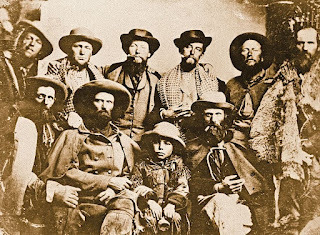
We will soonbe off on a trip along the Oregon Trail through southern Idaho and into westernOregon and Washington. There’s a lot of history along this nineteenth-centurysuperhighway.
Stretchedacross more than a hundred miles of the road is the history of one of thesaddest tales on the emigrant trails—a series of events known by various names,but most often as the Utter-Van Ornum Massacre. As with much of history, thereis a lot of confusion surrounding what happened. But here’s the gist of it.
ShoshoneIndians attacked an emigrant company of some 44 travelers somewhere west of thepresent location of Mountain Home, Idaho, and somewhere south of present-day Boise.Several pioneers were killed and after more fighting and needing water, four ofthe eight wagons were abandoned. The emigrants lost other people in attacksover the next few days as they traveled until the Shoshone departed. With little to eat, thetravelers left the remaining wagons and walked to the Owhyhee River, near the desertedFort Boise. Indians there traded salmon for the remainder of the emigrants’belongings and guns, then severe hunger set in.
The seniorVan Ornum, along with a few surviving members of the Utter family, left thehunger camp and moved on. The move did not save them, but it may have keptthem—at least the children—from being eaten. Four dead children were consumed inthe camp and there was talk of killing another for food. Instead, the body of aman dead ten days was exhumed, but before he was eaten help arrived and 12survivors were rescued.
Meanwhile,Indians had attacked and killed the Van Ornum party, except for three girls anda boy who were taken captive. It’s fairly certain the girls were soon killed,and perhaps the boy—but his fate remains a mystery. There were claims andstories of a white boy living with Indians at various places.
Respondingto one such story, the boy’s uncle came from Oregon and convinced army troopsfrom Camp Douglas in Utah to rescue the boy from a Shoshone band in CacheValley. After some shooting, some negotiating, and some double dealing, the boywas taken. Although he had light hair and eyes, his identity was and issuspect. He was about the right age to be the Van Ornum boy, but spoke noEnglish and was Shoshone in all his ways, and fought his “rescuers” to noavail. The Shoshone said he was the son of a French mountain man and a sisterof Chief Washakie. A photo memorializes the capture, with the boy in the bottomrow, flanked by the army officer who led the expedition and his uncle.
The uncletook him to Oregon, and to California soon after. Then history loses track ofthe boy, and his fate is unknown.
September 4, 2024
Poet on the Patio.

During rodeoweekend in St. George, Utah, The Book Bungalow will host yours truly as “Poet on thePatio” Saturday, September 14 at 10:00 a.m. Rodeo has been the inspiration fora good many of my poems, ranging from humor to thoughtful to ponderings on howthe sport challenges home and married life.
Mylong-ago rodeo travels did not take me to St. George for the PRCA rodeo—anevent that’s still going strong and will be held that weekend. But I didcompete in the Dixie College rodeo there a few times as a member of Utah State UniversityIntercollegiate Rodeo Team, and in 1973 won the bareback riding there. I stillwear the trophy buckle on occasion, although my belt back then wasn’t as longas it is nowadays.
If you areanywhere near the bottom corner of Utah that weekend, please drop by the patio outback of The Book Bungalow, located at 94 West Tabernacle Streetin St. George, Saturday, September 14 at 10:00 a.m. Bring your friends. Bringyour neighbors. Bring a smile (if you don’t bring one, come anyway—we’ll try tosend you home with one).

